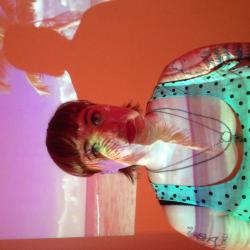
I’m clinging to the lighthouse rail at the top of Sugandisey, looking across the harbour onto Stykkishólmur. The wind is blowing powerfully and hawks soar above in the dusky clouds. Every time the green and red lights flash behind me as they rotate I get the sense that I’m about to be swept right off this sea-cliff into the cold ocean below. October might not be the most ideal time to visit the Snæfellsnes peninsula, but I’m damn glad I’m here.
Earlier, before climbing up to my potential-watery grave, I began my visit to this small town at a potential grave of water. The Library of Water opened in 2006 and it is a permanent installation by American artist Roni Horn, who became compelled by Iceland’s nature and weather to devote this project to the preservation of glaciers. It’s usually closed at this time of year, but manager Ragnheiður Óladóttir has unlocked it on request to give us a very intimate tour.
While the term ‘archive’ is most commonly associated with documents, which conserve concepts in a purely textual sense, this one is comprised of twenty-four glass columns containing water extracted from the core of each glacier in Iceland. As the glaciers recede from the effects of climate change, these columns will be the physical record that they once existed. “In fact, one glacier has already disappeared completely,” Ragnheiður says. “It was called Ok, and it’s not okay!” With weather-describing adjectives printed on the rubber floor and giant curved windows looking over the town and sea, the library is imbued with a quiet comfort and sense of purity.
Harbour chic
The connection between this town and water runs deeper than just the museum though. Owner of Hotel Egilsen Gréta Sigurðardóttir later explains that Stykkishólmur takes its water management very seriously. “We are the first town in Iceland to receive the Blue Flag eco-label for our harbour, because it is so clean,” she says proudly. The town recycles its hot water by re-injecting it into the ground and has partnered with four other communities on the peninsula to make the most effective waste management system in Iceland. This has earned Snæfellsnes the only Earth Check certification in Europe.
Gréta’s hotel, where I’m spending the night, looks like a cross-section of a barn from the outside and something out of a design catalogue on the inside. The narrow and intimate lobby and dining hall is adorned by locally crafted furniture and art and contains a bookshelf of impeccable first-edition replicates of classic novels by Charlotte Brontë and, of course, Jules Verne. The kind staff supplies me with a complementary iPad before handing over the keys to the stylish room, adorned with cold-cancelling blankets by Vík Þrjónsdóttir and l’Occitane en Provence toiletries. Holy crap this is fancy. I step into the shower and resolve to never, ever come out of this room again.
Gloomy beaches
After a wonderful night’s sleep, I do reluctantly depart from the lovely chambers to continue trekking around the peninsula. As we approach the tip of the land, Snæfellsjökull glacier is unfortunately shrouded by the weather. But after rounding the top of a fantastic lookout cliff, I finally see one of the most distinctive features of this region—golden sand beaches. Far from looking tropical, these sands are still heavily mixed with black volcanic fare and look like a glitter-on-the-disco-bloodbath dance floor. So despite the heavy wind, I jump out of the car as soon as we reach the northern tip at Öndverðarnes and run down the beach to the shore, where giant waves crash against blunt black cliffs.
Another few minutes down the road and suddenly there’s a giant sign: “HVALREKI/DEAD WHALE.” Past the ruins of one of the oldest sheep round-up structures and just a quick climb over a black rock embankment, sure enough, there is a rotting carcass of a sperm whale. It does not smell as bad as one would think! In fact, it’s at this point I realise it’s time for lunch, so I head to Hellnar to try a restaurant recommended by Gréta. Fjöruborðið is neither the easiest café to find nor the easiest to access, even in a compact vehicle. But it proves to be well-worth taking the steep road down to it for the delicious fish soup, chicken quiche, and an astounding view of a sea-cave.
As luck would have it, the sun comes out while I’m eating and on the drive back up to the main road, I see the gem of the peninsula—the glacier made infamous by Jules Verne and rendered immortal by Roni Horn.
—
Distance from Reykjavík: 165 km. Car rental provided by Hertz (www.hertz.is) and accommodation by Hotel Egilsen (www.egilsen.is). For more information about Stykkishólmur and the Library of Water go to www.stykkisholmur.is
Buy subscriptions, t-shirts and more from our shop right here!















